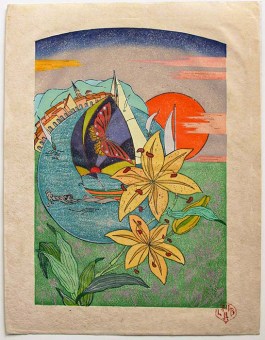Ask a question
Giovanni Berio / LIGUSTRO (1924-2015)
(Stampa Oneglia nei colori e nel segno dello Zen variante 1)
173-color polychrome woodcut, year 1999
Issues: 2 with different colors and papers
Techniques used in use in the EDO period in Japan:
Nishiki-E: Brocade prints, a term used to denote the coloured woodcuts produced from 1765 onward using cherry and pear woods
Bokashi: Shaded colour printing
Karazuri: Printing whit parts created by pressure alone, without colour, in order to create relief and three-dimensional effect
Kimekomi: Printing using the reverse of the Karazuri technique giving an engraved, grooved effect
Kinpaku: Use of gold leaf to cover larger areas of the print
Wood: The engravings for the contours and for the clichés were made on cherry wood (Sakura)
Paper: Japanese fine paper
Size of the print: cm 32 cm x 42 cm
Chinese cinnabar seals
Signature: Seal bottom right RI-GU Ligustro
NOTE: THE ZEN CIRCLE CAN BE NOTED IN THE PRINT ...
The resumption of trade with China, which under the Ming (1368 - 1644) was then witnessing a marvelous renewal of its culture, brought ferments and stimuli to Japan that gave art a new face and a new vitality.
A fundamental element in this fervor of transformations is Zen, which by now inspires and pervades everything.
The essential characteristics of the art of this period are due to his influence; great sobriety and composed elegance combined with admirable freshness ...
